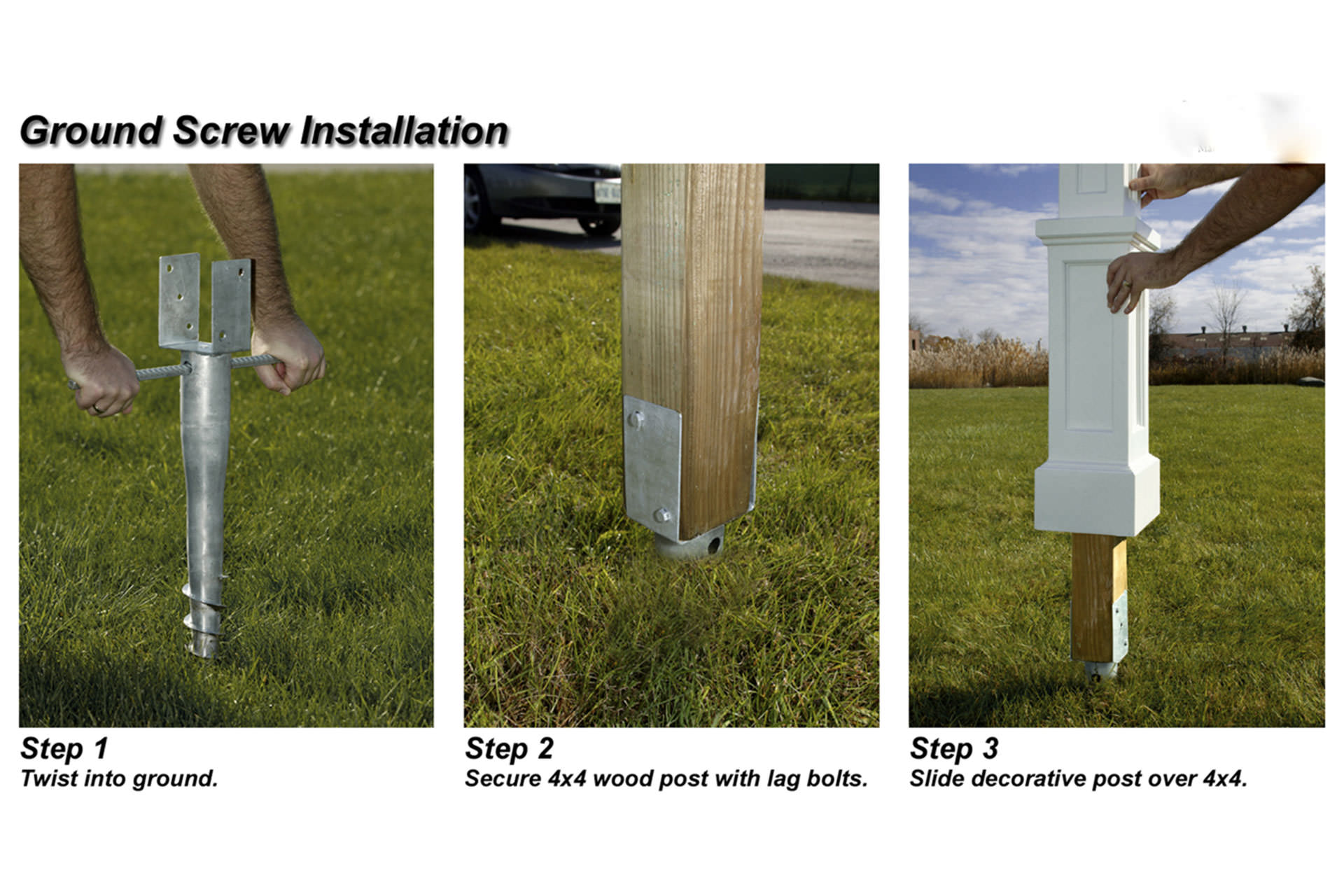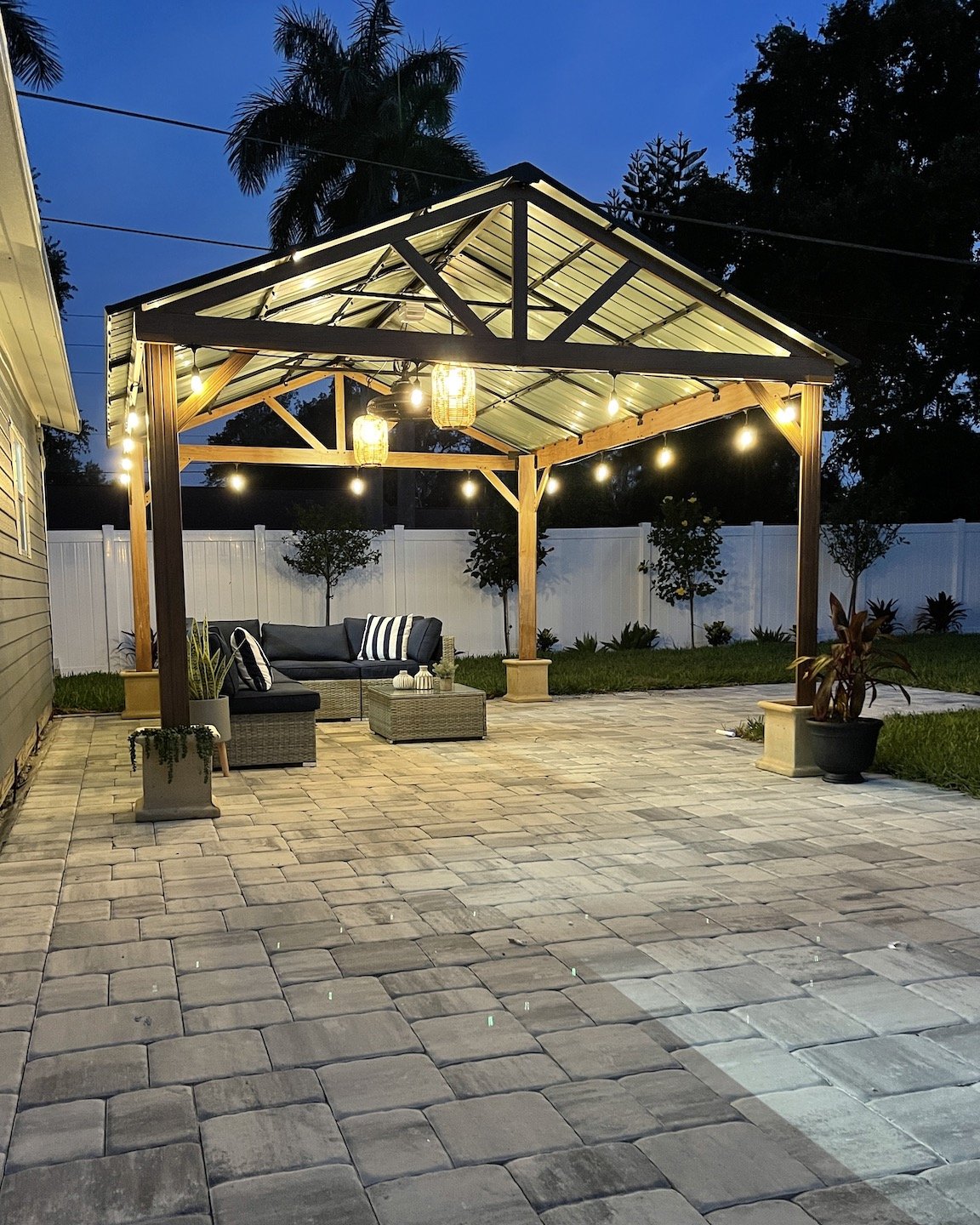How to anchor a pergola to pavers? To anchor a pergola to pavers, you can use anchor bolts or concrete screw anchors. Anchoring a pergola to pavers is essential to ensure stability and safety.
Whether you’re adding a pergola to your backyard or patio, securing it properly is vital to prevent it from shifting or toppling over during strong winds or heavy loads. By following a few simple steps, you can anchor your pergola to pavers and enjoy a sturdy outdoor structure that will withstand the test of time.
In this article, we will discuss the methods of using anchor bolts or concrete screw anchors to secure your pergola to pavers efficiently. With these anchoring techniques, you can enjoy your pergola and the outdoor space it provides with peace of mind.

Credit: www.shadefxcanopies.com
Introduction To Anchoring Pergolas To Pavers
Pergolas are a popular addition to outdoor spaces, providing shade, beauty, and a comfortable gathering spot. When installing a pergola, it’s crucial to anchor it securely to prevent any accidents or damage. In this section, we will explore the importance and benefits of anchoring a pergola to pavers, as well as the common challenges that may arise.
Importance And Benefits Of Anchoring A Pergola:
- Safety: Anchoring a pergola to pavers ensures stability, preventing it from tipping over during strong winds or storms.
- Durability: By securely fastening the pergola to the pavers, you increase its longevity, as it will remain in place even in harsh weather conditions.
- Structural integrity: The anchoring mechanism provides the necessary support to maintain the structural integrity of the pergola, keeping it level and sturdy over time.
- Aesthetics: Anchoring a pergola adds to its overall appearance, creating a polished and finished look that enhances the beauty of your outdoor space.
Common Challenges Faced When Anchoring To Pavers:
- Correct placement: Positioning the pergola correctly on the pavers is crucial to ensure stability and prevent any damage to the pavers themselves.
- Anchoring options: Choosing the right anchoring method can be challenging, as different pavers require different mechanisms for secure attachment.
- Leveling: Achieving a level base for the pergola can be tricky, especially when dealing with uneven or sloping pavers. It’s essential to address this issue to ensure the pergola’s stability and proper functionality.
- Paver material: Different types of pavers may require specific anchoring techniques or materials, such as adhesive anchors for concrete pavers or screw anchors for brick pavers. It’s important to consider the composition of the pavers when selecting the anchoring method.
Properly anchoring a pergola to pavers is crucial for its longevity and your safety. Understanding the importance and benefits of secure anchoring, as well as the common challenges that may arise, will help you navigate the installation process with confidence.
In the following sections, we will delve deeper into the various anchoring methods and provide step-by-step instructions to anchor your pergola securely to pavers.
Understanding The Paver Surface
When it comes to anchoring a pergola to pavers, understanding the paver surface is crucial. The material composition and characteristics of the pavers will determine the anchoring options available to you. Additionally, factors such as the type of pavers used and their installation technique can have an impact on the stability and durability of the pergola anchor.
Let’s delve deeper into these key aspects:
Material Composition And Characteristics Of Pavers
Pavers are commonly made from various materials such as concrete, natural stone, or brick, each with its own unique qualities and properties. Here are some important points to consider regarding paver material composition and characteristics:
- Concrete pavers: Durable and cost-effective, these pavers come in a wide range of sizes, shapes, and colors. They are resistant to cracking and can withstand heavy loads.
- Natural stone pavers: Known for their timeless beauty, natural stone pavers offer a unique aesthetic appeal. However, they may require more maintenance and can be more expensive compared to other options.
- Brick pavers: Classic and versatile, brick pavers are popular for their strength and durability. They are available in a variety of colors and textures, adding a charming touch to any outdoor space.
- Interlocking pavers: These pavers are designed to fit together seamlessly, creating a stable and uniform surface. They provide strength and flexibility, making them suitable for various applications.
Factors To Consider When Choosing Pavers For A Pergola Anchor
Selecting the right pavers for anchoring a pergola is essential for long-term stability and safety. Consider the following factors when choosing pavers for your project:
- Weight-bearing capacity: Ensure that the selected pavers can withstand the weight of the pergola and any additional loads, such as hanging plants or lighting fixtures.
- Size and shape: The size and shape of the pavers should be compatible with the size and layout of the pergola. It’s important to choose pavers that can be easily integrated with the anchor system.
- Material suitability: Evaluate the material properties of the pavers in relation to the local climate and environmental conditions. Factors such as freeze-thaw cycles, rainfall, and exposure to direct sunlight can impact the performance of the pavers over time.
- Aesthetic appeal: Consider the overall design and style of your outdoor space. Choose pavers that complement the existing landscape and enhance the visual appeal of your pergola.
Impact Of Paver Installation Technique On Anchoring Options
The installation technique of the pavers can significantly impact the available options for anchoring the pergola. Here are some important points to keep in mind:
- Traditional paver installation: If the pavers are installed using traditional methods, such as a sand or gravel base, there may be limitations on the type of anchor systems that can be used. In such cases, surface-mounted anchors or freestanding pergola designs might be more suitable.
- Interlocking paver installation: Interlocking pavers, with their uniform and stable surface, allow for a wider range of anchor options. Integrated anchor systems can be installed during the paver installation process, providing a seamless and secure connection between the pergola and the pavers.
- Consult a professional: It is recommended to consult with a professional contractor or engineer who specializes in paver installations and pergola anchoring. They will assess the specific conditions of your project and provide guidance on the most suitable anchoring options based on the paver installation technique.
Understanding the paver surface is key to ensuring the stability and longevity of a pergola anchor. By considering the material composition, characteristics, and installation technique of the pavers, you can make informed decisions when choosing the right anchor system for your pergola.
Determining The Ideal Anchoring Method
When it comes to anchoring a pergola to pavers, there are several options to choose from. It’s important to consider both the structural stability and aesthetic appeal of your pergola, ensuring it blends seamlessly with your outdoor space. Let’s take a closer look at the different anchoring options for pavers and the factors you should consider when selecting the best method for your pergola.
Examination Of Different Anchoring Options For Pavers:
- Bolted anchors: This method involves securing the pergola posts to the pavers using heavy-duty bolts. It provides a strong and stable foundation, ensuring the pergola remains firmly in place even during strong winds or harsh weather conditions.
- Concrete anchors: By embedding anchors into the pavers and pouring concrete around them, you create a solid and durable base for your pergola. This method offers excellent stability and can support larger pergola structures.
- Adjustable supports: These innovative anchors allow you to easily adjust the height and level of your pergola. This is particularly useful for uneven or sloping surfaces, ensuring your pergola is perfectly aligned and balanced.
- Surface-mounted brackets: This method involves attaching brackets to the surface of the pavers and securing the pergola posts to them. It offers a simple and cost-effective solution for anchoring your pergola.
Factors To Consider When Selecting The Best Method For Your Pergola:
- Location: Consider the geographical location and climate of your area. If you live in a region with high wind or heavy snowfall, you may need a more robust anchoring method to ensure the stability of your pergola.
- Pergola size: The size and weight of your pergola will influence the type of anchoring method you choose. Larger and heavier pergolas will require stronger anchors to support the added load.
- Aesthetics: Take into account the visual appearance of the anchoring method. You want it to complement the overall design of your pergola and enhance the aesthetic appeal of your outdoor space.
- Compliance: Check local building codes and regulations to ensure you comply with any requirements for pergola anchoring. Some areas may have specific guidelines that dictate the type and installation of anchors.
- Versatility: Consider the future adaptability of your pergola. If you have plans to make changes or additions, choose an anchoring method that allows for easy adjustments or modifications.
By carefully evaluating these factors, you can determine the ideal anchoring method for your pergola that ensures both stability and aesthetic appeal. Remember, it’s crucial to prioritize safety and seek professional assistance if needed during the installation process.
Step-By-Step Guide To Anchoring A Pergola To Pavers
A pergola is a beautiful addition to any outdoor space, providing shade and a cozy atmosphere for relaxation or entertaining. Anchoring a pergola to pavers is important to ensure stability and safety. In this step-by-step guide, we will walk you through the process of securely anchoring your pergola to pavers, using various methods.
Essential Tools And Materials Needed For The Project:
- Tape measure: To accurately measure the dimensions and distances.
- Drill: For creating holes.
- Masonry bit: To drill into the pavers.
- Concrete anchors: Used to secure the pergola to the pavers.
- Expansion anchors or wedge anchors: Another option for anchoring the pergola.
- Anchor plates and bolts: Used for attaching the pergola to the pavers.
- Ground screws or helical piles: An alternative method of anchoring.
- Surface-mounted brackets: To install the pergola using lag screws.
Preparation Steps For The Paver Surface And Pergola Setup:
- Measure and mark the desired location for the pergola.
- Clear the area of any obstructions, such as plants or furniture.
- Clean the pavers to ensure a smooth surface for anchoring.
- Determine the method of anchoring based on the type of pergola and pavers you have.
- Assemble the pergola according to the manufacturer’s instructions.
Detailed Instructions For Each Anchoring Method:
Anchoring with concrete anchors:
- Place the pergola in the desired spot, ensuring it is level.
- Mark the holes on the pavers where the concrete anchors will go.
- Drill holes into the pavers at the marked-spots.
- Insert the concrete anchors into the holes and tighten them using a wrench.
- Attach the pergola to the concrete anchors using bolts or screws.
Using expansion anchors or wedge anchors:
- Position the pergola where you want it to be.
- Mark the holes on the pavers for the anchors.
- Drill holes into the pavers at the marked-spots.
- Insert the expansion anchors or wedge anchors into the holes.
- Tighten the expansion anchors or wedge anchors to secure the pergola.
Attaching with anchor plates and bolts:
- Place the anchor plates on the pavers where the pergola will be anchored.
- Mark the holes on the pavers through the pre-drilled holes on the anchor plates.
- Drill holes into the pavers at the marked-spots.
- Attach the anchor plates to the pavers using bolts.
- Secure the pergola to the anchor plates using nuts and washers.
Utilizing ground screws or helical piles:
- Position the ground screws or helical piles where the pergola will be installed.
- Use a drill to twist the ground screws or helical piles into the ground.
- Attach the pergola to the top of the ground screws or helical piles using brackets or other suitable methods.
Installing surface-mounted brackets with lag screws:
- Place the surface-mounted brackets on the pavers.
- Mark the holes on the pavers through the pre-drilled holes on the brackets.
- Drill holes into the pavers at the marked-spots.
- Attach the brackets to the pavers using lag screws.
- Secure the pergola to the brackets using appropriate fasteners.
By following these step-by-step instructions and using the right tools and materials, you can ensure that your pergola is properly anchored to the pavers, providing a sturdy and safe outdoor structure for years to come.
Tips For Ensuring A Secure Pergola Anchor
Proper spacing and positioning of anchor points on the pavers:
- Measure and mark the desired location for the anchor points on the pavers before drilling.
- Ensure that the spacing between the anchor points is even to provide balanced support for the pergola.
- Consider the dimensions and weight distribution of the pergola when determining the position of the anchor points.
Considerations for weight distribution and load-bearing capacity:
- Take into account the weight of the pergola, including any additional accessories or features, to determine the load-bearing capacity required for the anchor system.
- Pavers should be thick and sturdy enough to bear the weight of the pergola and withstand any potential lateral forces, such as strong winds or heavy rain.
- Consult a professional or structural engineer if you are unsure about the weight distribution and load-bearing capacity of your pavers.
Techniques for ensuring tight and durable connections:
- Use appropriate anchor hardware, such as screws or bolts, that are designed for outdoor use and can withstand the elements.
- Pre-drill the anchor holes in the pavers to ensure a precise and secure fit.
- Tighten the anchor hardware securely but avoid over-tightening, as this could damage the pavers or create stress points that reduce the anchor’s effectiveness.
Regular maintenance practices to keep the anchor system strong:
- Regularly inspect the anchor connections and hardware for any signs of damage or looseness.
- Tighten any loose anchor hardware to maintain a secure connection.
- Clean and remove any debris or dirt that may accumulate around the anchor system to prevent corrosion.
By following these tips for ensuring a secure pergola anchor, you can enjoy your outdoor space with confidence, knowing that your pergola is safely anchored to your pavers.
Frequently Asked Questions On How To Anchor A Pergola To Pavers!
How Do I Anchor A Pergola To Pavers?
To anchor a pergola to pavers, start by marking the positions where you want to anchor the pergola. Use a masonry drill bit to create-holes in the pavers. Insert anchor bolts into the holes and tighten them with a wrench.
Finally, attach the pergola posts to the anchor bolts using bolts or screws.
Are Pavers Strong Enough To Anchor A Pergola?
Pavers are generally strong enough to anchor a pergola, as long as they are installed correctly and are thick enough to withstand the weight and pressure. However, it’s important to ensure that the pavers have a solid foundation and are in good condition before proceeding with the anchoring process.
What Type Of Anchor Bolts Should I Use For Anchoring A Pergola To Pavers?
Stainless steel wedge anchor bolts are commonly used for anchoring a pergola to pavers. These bolts provide a strong and secure connection, as they expand when tightened, creating a tight hold. Ensure that the size and length of the anchor bolts are appropriate for your pergola and paver thickness.
Conclusion
Anchoring a pergola to pavers is a crucial step in ensuring its stability and longevity. By following the steps outlined in this blog post, you can successfully secure your pergola to pavers and enjoy the benefits of a sturdy and beautiful outdoor structure.
Remember to carefully choose the right anchor system for your specific paver material and pergola design. Additionally, ensure that the anchor points are evenly spaced and securely fastened to both the pavers and the pergola posts. Regular maintenance and inspections are also important to ensure that the anchoring system remains intact and effective.
With proper installation and maintenance, you can create a stunning outdoor space that withstands the test of time. So, why wait? Get started on anchoring your pergola to pavers today and enjoy the beauty and functionality it brings to your outdoor living area.

